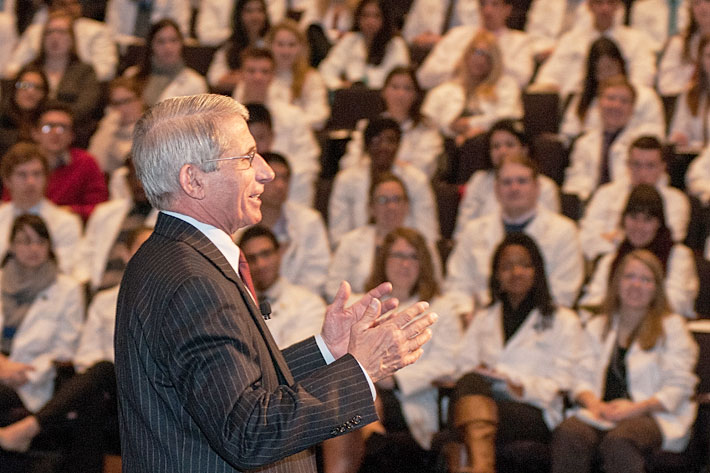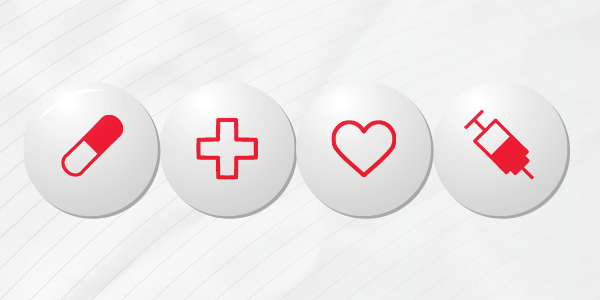Anthony Fauci’s colleagues called him crazy when as a young and successful immunologist, he decided to focus his attention entirely on a mysterious disease that was infecting gay men in 1981.
“They said, why are you throwing away your career on a group of less than 100 gay men from cities like L.A., San Francisco and New York?” said Dr. Fauci, the director of the NIH’s National Institute of Allergy and Infectious Diseases since 1984, to a group of first-year medical students at the George Washington University on Monday.
Dr. Fauci’s remarks kicked off a three-day event for the students in the School of Medicine and Health Sciences, the first of a number of special projects intended to introduce GW’s future physicians to clinical public health topics.
In June 1981, Dr. Fauci received an article, published in the Morbidity and Mortality Weekly Report, which stated that five previously healthy, young gay men in Los Angeles had been diagnosed with Pneumocystis carinii pneumonia, an infection that usually appears only in those with significant immune system damage.
Dr. Fauci disregarded the news, calling it a “fluke.” But a month later, when 23 more cases appeared, the physician knew he wanted to investigate the disease that would eventually be called AIDS.
More than three decades after the first recorded HIV/AIDS reports, scientific advancements have dramatically improved the life expectancy of those infected with the virus.
But still, the epidemic “ain’t over ’til it’s over,” said Dr. Fauci, evoking the words of fellow New York icon Yogi Berra. Today, more than 1.2 million Americans are living with HIV, and almost 14 percent are unaware they are infected, according to the Centers for Disease Control and Prevention. The latest numbers show a 132.5 percent increase in new HIV infections, from 2002 to 2011 among gay and bisexual men in the 13-24 age range, which Dr. Fauci called an “embarrassment.”
“And so, as I wrote just last year with my colleagues from the NIH, even though we’ve accomplished a lot, and we have a lot to be proud of, there is still much to do,” Dr. Fauci said. “Now is not the time for a victory lap, but the time for racing ahead.”
As part of GW medical students’ clinical public health curriculum, a new element of the SMHS M.D. program, they are participating in a group-based exercise in which they will develop an implementation proposal to improve parts of the HIV Care Continuum. The continuum is a model used by federal, state and local agencies to identify opportunities related to improving services for those living with HIV/AIDS.
The goal of the project is to prepare the next generation of physicians to understand their role as community health leaders. After creating their proposals, student representatives from each group will present their projects to a panel of government and interest groups at the White House on Wednesday.
Before students began their proposal planning on Monday, they heard from physicians who have been on the frontlines of domestic and global AIDS issues, including Dr. Fauci, White House Advisor Maggie Czarnogorski and Ronald O. Valdiserri from the Department of Health and Human Services.
Dr. Fauci spoke candidly in Betts Marvin Theatre to the M.D. class of 2018 about the history of HIV/AIDS in the United States and how the virus changed the trajectory of his career. The physician has been instrumental in the understanding of and fight against HIV/AIDS, both in the United States and abroad. His research has led to therapies that could extend the life of a HIV/AIDS patient by 50 years.
For example, Dr. Fauci and other scientists also found that early antiretroviral therapy could be used not only to treat an infected person, but also to prevent spreading the disease. A person on this treatment has a 96 percent less chance of transmitting the infection to his or her sexual partner.
“We went from a catastrophe to a point where you could actually start talking about ending AIDS. With all the drugs, and the implementation globally, there has been a 35 percent decrease in deaths by 2005,” Dr. Fauci said. “Also, what happened over the years, there was the scientific medical application of prevention.”
He said he never intended to become involved with government but accepted his position with the NIH because he realized that if you want to make a difference, “you have to interact with people who make policy.”
Dr. Fauci recalled the influence of AIDS activists in the mid-1980s, who at first “stormed the NIH” and threw smoke bombs at the physician who they believed was the enemy. Rather than push them away, Dr. Fauci invited them inside to speak, giving them a voice in how clinical trials operated at that time.
He also acknowledged the criticism pointed at President Ronald Reagan for not publicly addressing AIDS until his second term. However, he said, privately President Reagan graciously supported AIDS research.
“If you want to get things done, you cannot have ideology,” he said.
In the early 2000s, President George W. Bush sent Dr. Fauci to Africa to assess how the United States could develop a base program to bring HIV care, prevention and treatment to the region. Dr. Fauci worked with White House staffers to develop a program for the president, which he accepted and named the President’s Emergency Plan for AIDS Relief (PEPFAR).
The program initially prevented 7 million new infections. From 2003 to 2014, PEPFAR counseled and tested almost 60 million people.
While now there is a “scientific base for a world without AIDS,” Dr. Fauci stressed that there are still a number of hurdles that must be overcome, and it will be “up to you” to solve them, he told the room of future doctors.
He urged the medical students to get involved in policy work and specifically, to target “hot spots” or specific communities rather than thinking about “one-size-fits-all” prevention plans.
“This is particularly relevant for you in this class because it’s going to be up to you to bring that over the goal line,” Dr. Fauci said. “It’s not going to happen spontaneously.”



